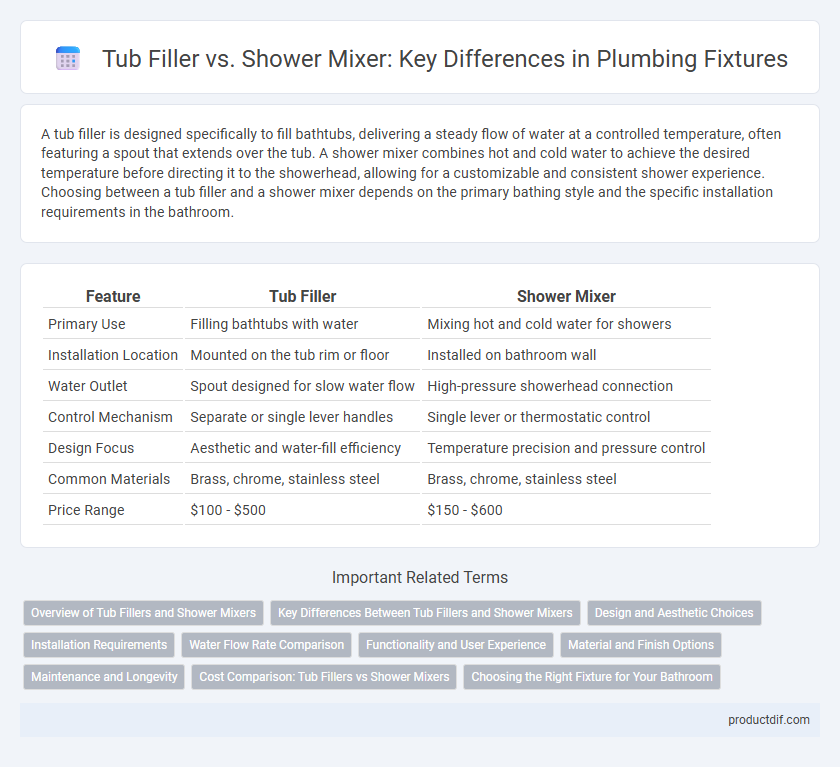A tub filler is designed specifically to fill bathtubs, delivering a steady flow of water at a controlled temperature, often featuring a spout that extends over the tub. A shower mixer combines hot and cold water to achieve the desired temperature before directing it to the showerhead, allowing for a customizable and consistent shower experience. Choosing between a tub filler and a shower mixer depends on the primary bathing style and the specific installation requirements in the bathroom.
Table of Comparison
| Feature | Tub Filler | Shower Mixer |
|---|---|---|
| Primary Use | Filling bathtubs with water | Mixing hot and cold water for showers |
| Installation Location | Mounted on the tub rim or floor | Installed on bathroom wall |
| Water Outlet | Spout designed for slow water flow | High-pressure showerhead connection |
| Control Mechanism | Separate or single lever handles | Single lever or thermostatic control |
| Design Focus | Aesthetic and water-fill efficiency | Temperature precision and pressure control |
| Common Materials | Brass, chrome, stainless steel | Brass, chrome, stainless steel |
| Price Range | $100 - $500 | $150 - $600 |
Overview of Tub Fillers and Shower Mixers
Tub fillers are plumbing fixtures designed to fill bathtubs efficiently, typically featuring higher flow rates and options for hand showers or spouts for easy water control. Shower mixers combine hot and cold water to deliver a consistent temperature through showerheads, often incorporating thermostatic valves for safety and comfort. Both fixtures prioritize user convenience but serve distinct purposes based on bathtub filling versus shower water temperature regulation.
Key Differences Between Tub Fillers and Shower Mixers
Tub fillers are designed specifically to fill bathtubs with water, featuring a spout that delivers high flow rates and often includes handheld spray attachments for ease of use. Shower mixers combine hot and cold water to regulate temperature while controlling water flow through a showerhead, optimized for consistent temperature control and water pressure. Unlike tub fillers, shower mixers prioritize ergonomics and safety features such as anti-scald technology to enhance showering comfort.
Design and Aesthetic Choices
Tub fillers often feature elegant, freestanding designs that serve as a focal point in bathroom decor, emphasizing luxury and style. Shower mixers prioritize streamlined, wall-mounted units that blend seamlessly with modern bathroom aesthetics, maximizing space and minimizing visual clutter. Choosing between these fixtures depends on the desired balance between statement pieces and minimalist functionality in bathroom design.
Installation Requirements
Tub fillers require precise wall or deck mounting with access to both hot and cold water supply lines, often demanding reinforced structural support for heavier models. Shower mixers, typically wall-mounted, need proper alignment with concealed plumbing to ensure smooth temperature and flow control, often integrating seamlessly with existing shower valve installations. Installation complexity varies, with tub fillers sometimes requiring additional plumbing modifications compared to the more standardized setup of shower mixers.
Water Flow Rate Comparison
Tub fillers generally have a higher water flow rate, often reaching up to 20 gallons per minute, to quickly fill bathtubs efficiently. Shower mixers typically maintain a lower flow rate around 2 to 5 gallons per minute, optimizing water conservation while ensuring consistent temperature control. Understanding these flow rate differences is essential for selecting fixtures that balance filling speed and water usage.
Functionality and User Experience
Tub fillers provide precise water control for filling bathtubs efficiently, featuring separate hot and cold water handles that allow users to adjust temperature and flow rate directly. Shower mixers combine hot and cold water in a single valve, simplifying temperature regulation and enhancing user convenience during showers by maintaining consistent water pressure and temperature. The choice between a tub filler and shower mixer impacts overall user experience through differences in installation flexibility and ease of adjusting water settings for bathing or showering.
Material and Finish Options
Tub fillers and shower mixers offer various material and finish options tailored to durability and style preferences. Common materials include brass, stainless steel, and zinc alloy, chosen for corrosion resistance and longevity in wet environments. Finish options such as chrome, brushed nickel, oil-rubbed bronze, and matte black enhance aesthetic appeal while providing additional surface protection.
Maintenance and Longevity
Tub fillers usually require less frequent maintenance due to simpler mechanical parts and lower exposure to water flow compared to shower mixers, which often have more complex valve systems that can be prone to mineral buildup. Shower mixers need regular cleaning and occasional cartridge replacement to ensure longevity, as continuous water pressure and temperature adjustments increase wear. High-quality materials such as brass or stainless steel in both fixtures enhance durability and reduce the risk of corrosion and leaks over time.
Cost Comparison: Tub Fillers vs Shower Mixers
Tub fillers typically cost between $150 and $500, with luxury models reaching up to $1,000, while shower mixers generally range from $100 to $400 depending on features and brand. Installation expenses for tub fillers can be higher due to the need for additional piping and wall mounting, compared to shower mixers that often integrate directly with existing shower plumbing. Maintenance costs are generally similar, but shower mixers may incur more frequent repairs due to integrated thermostatic valves and diverters.
Choosing the Right Fixture for Your Bathroom
When choosing the right fixture for your bathroom, consider the functional differences between a tub filler and a shower mixer; a tub filler is designed specifically to fill bathtubs with water quickly and often includes handheld shower attachments, while a shower mixer controls water temperature and flow for an overhead or wall-mounted showerhead. Opt for a tub filler if your bathroom layout emphasizes bathing convenience and aesthetic appeal, ensuring a smooth water flow directly into the tub. Select a shower mixer for efficient water control in showers, providing precise temperature regulation and optimal user comfort.
Tub filler vs Shower mixer Infographic

 productdif.com
productdif.com